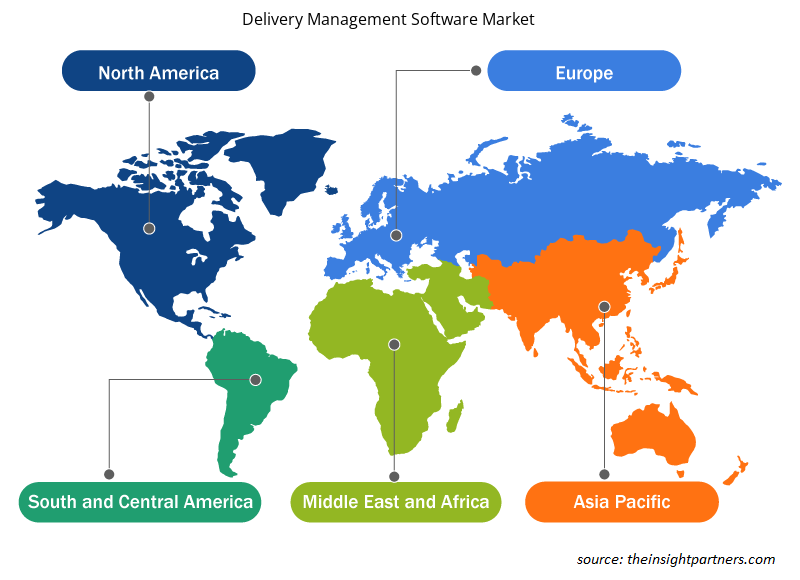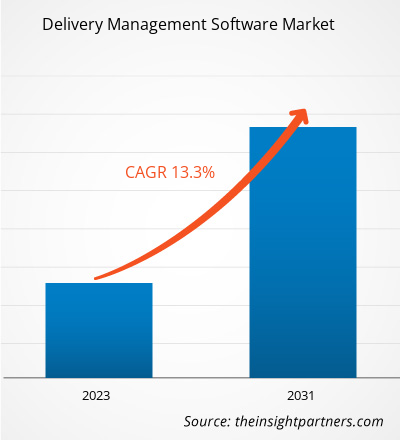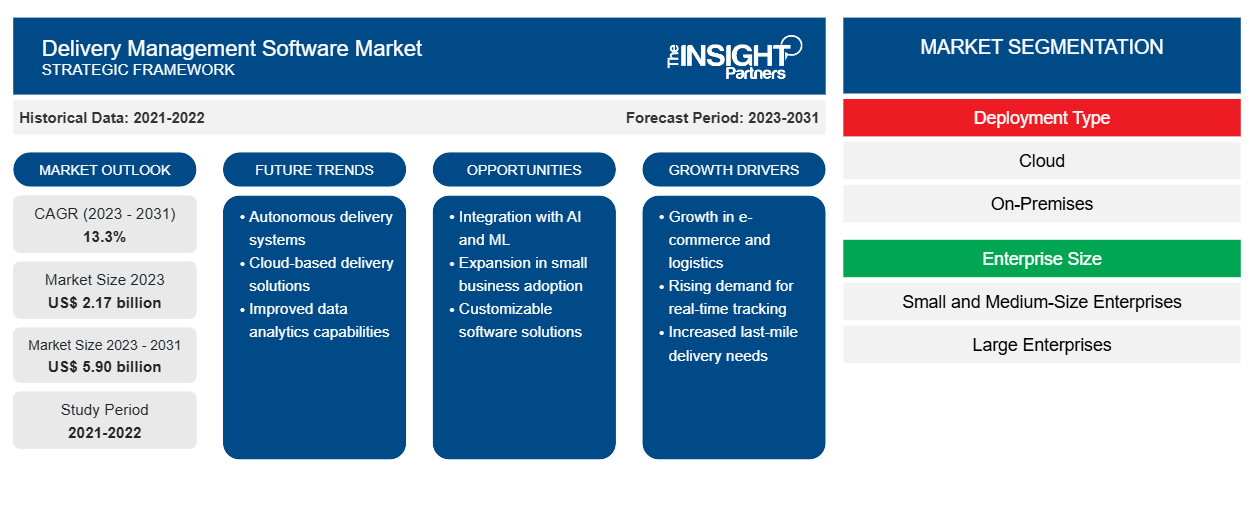Si prevede che il mercato del software di gestione delle consegne raggiungerà i 5,90 miliardi di dollari entro il 2031, rispetto ai 2,17 miliardi di dollari del 2023. Si prevede che il mercato registrerà un CAGR del 13,3% dal 2023 al 2031.
È probabile che l'integrazione delle tecnologie AI e ML nel software di gestione delle consegne per migliorare l'esperienza del consumatore rimanga una tendenza chiave del mercato dei software di gestione delle consegne.
Analisi di mercato del software di gestione delle consegne
Il mercato del software di gestione delle consegne sta crescendo a un ritmo rapido a causa dell'espansione del settore dell'e-commerce e della crescente domanda di informazioni in tempo reale per la gestione della logistica e delle catene di fornitura. Il mercato si sta espandendo costantemente, guidato dalla crescita della popolazione, dalla crescente digitalizzazione e dalla preferenza dei consumatori per lo shopping online. Inoltre, la crescente domanda di automazione da parte degli utenti finali sta offrendo opportunità redditizie per la crescita del mercato. digitalization, and consumer preference for online shopping. Moreover, the growing demand for automation by end users is providing lucrative opportunities for market growth.
Panoramica del mercato del software di gestione delle consegne
Il software di gestione delle consegne viene utilizzato per tracciare le spedizioni e garantire la consegna puntuale degli articoli ai clienti. L'uso di un software di gestione delle consegne innovativo offre notevoli vantaggi alle aziende, tra cui l'aumento dell'utilizzo delle risorse, il miglioramento della soddisfazione del cliente e la riduzione del consumo di carburante. Il software collega il conducente della consegna e gli uffici back-end su un'unica piattaforma e fornisce le informazioni necessarie al conducente per consegnare un articolo. La crescente domanda di informazioni in tempo reale e di un migliore monitoraggio delle consegne sta dando impulso al mercato.
Personalizza questo report in base alle tue esigenze
Riceverai la personalizzazione gratuita di qualsiasi report, comprese parti di questo report, o analisi a livello nazionale, pacchetto dati Excel, oltre a usufruire di grandi offerte e sconti per start-up e università
-
Scopri le principali tendenze di mercato in questo rapporto.Questo campione GRATUITO includerà analisi di dati che spaziano dalle tendenze di mercato alle stime e alle previsioni.
Driver e opportunità di mercato del software di gestione delle consegne
L'espansione del settore dell'e-commerce sta guidando il mercato
L'espansione del settore dell'e-commerce e la crescente domanda di servizi di consegna dell'ultimo miglio tra i consumatori stanno alimentando il mercato. Il business dell'e-commerce si sta espandendo rapidamente in tutto il mondo, poiché sempre più consumatori preferiscono lo shopping online come opzione conveniente. Ciò si traduce in una crescente domanda di servizi di consegna tra i consumatori, in particolare la consegna dell'ultimo miglio. La consegna dell'ultimo miglio è una parte cruciale del business dell'e-commerce. Comporta il trasporto di merci dal magazzino alla porta del cliente. Le aziende di e-commerce si stanno concentrando sull'assicurare che i loro articoli raggiungano i clienti in modo rapido ed economico, il che aumenta la domanda di software di gestione delle consegne tra le aziende. Tuttavia, l'espansione del settore dell'e-commerce e lo spostamento delle preferenze dei consumatori verso lo shopping online stanno alimentando il mercato.
Crescente domanda di automazione da parte degli utenti finali: un'opportunità nel mercato del software di gestione delle consegne
L'emergere di tecnologie all'avanguardia presenta un potenziale di crescita redditizio per il mercato del software di gestione delle consegne. I grandi attori del mercato del software di gestione delle consegne stanno effettuando investimenti significativi nell'adozione di tecnologie AI e ML per automatizzare i loro processi di consegna. Inoltre, l'automazione sta guadagnando sempre più terreno nella gestione delle consegne supportando le aziende nel migliorare le loro procedure di evasione degli ordini e consegna. L'automazione aiuta gli utenti finali, come la consegna di ristoranti, la logistica, le attività di corriere e altri, a semplificare le procedure, ridurre i costi e migliorare l'esperienza del cliente. Numerose tecnologie di automazione come l'ottimizzazione del percorso, i portali self-service e la consegna automatizzata sono ampiamente adottate dalle aziende di logistica per una consegna dei prodotti più rapida ed efficace.
Analisi della segmentazione del rapporto di mercato del software di gestione delle consegne
I segmenti chiave che hanno contribuito alla derivazione dell'analisi di mercato del software di gestione delle consegne sono il tipo di distribuzione, le dimensioni dell'azienda e l'utente finale.
- In base al tipo di distribuzione, il mercato del software di delivery management è suddiviso in cloud e on-premise. Il segmento cloud ha detenuto una quota di mercato maggiore nel 2023.
- In termini di dimensioni aziendali, il mercato del software di delivery management è suddiviso in piccole e medie imprese e grandi imprese. Il segmento delle grandi imprese ha detenuto una quota di mercato maggiore nel 2023.
- Sulla base dell'utente finale, il mercato è segmentato in consegne di ristoranti, logistica, attività di corriere e altri. Il segmento della logistica ha detenuto la quota maggiore del mercato nel 2023.
Analisi della quota di mercato del software di gestione delle consegne per area geografica
L'ambito geografico del rapporto di mercato sul software di gestione delle consegne è suddiviso principalmente in cinque regioni: Nord America, Asia Pacifico, Europa, Medio Oriente e Africa e Sud America/Sud e Centro America.
In termini di fatturato, l'Asia Pacifica ha rappresentato la quota di mercato più grande per il software di gestione delle consegne, l'espansione del settore dell'e-commerce, la crescita della popolazione e la preferenza dei consumatori per lo shopping online. La crescente domanda di software di gestione delle consegne tra le aziende per semplificare i loro processi di consegna riducendo i costi logistici aggiuntivi sta guidando il mercato. Inoltre, il progresso tecnologico e la crescente domanda di software basati su cloud per la gestione appropriata della consegna dei prodotti stanno creando opportunità nel mercato.
Notizie di mercato e sviluppi recenti del software di gestione delle consegne
Il mercato del software di gestione delle consegne viene valutato raccogliendo dati qualitativi e quantitativi dopo la ricerca primaria e secondaria, che include importanti pubblicazioni aziendali, dati associativi e database. Di seguito è riportato un elenco degli sviluppi nel mercato del software e delle strategie di gestione delle consegne:
- Nel febbraio 2024, Inspire Brands ha acquistato "Vromo" per semplificare i canali di consegna. Vromo è un software di consegna di cibo online che supporta Inspire Brands nel gestire il suo processo di consegna offrendo vantaggi di tracciamento della consegna al cliente finale. (Fonte: Inspire Brands, comunicato stampa, 2024)
Approfondimenti regionali sul mercato del software di gestione delle consegne
Le tendenze regionali e i fattori che influenzano il mercato del software di gestione delle consegne durante il periodo di previsione sono stati ampiamente spiegati dagli analisti di Insight Partners. Questa sezione discute anche i segmenti e la geografia del mercato del software di gestione delle consegne in Nord America, Europa, Asia Pacifico, Medio Oriente e Africa e America meridionale e centrale.

- Ottieni i dati specifici regionali per il mercato del software di gestione delle consegne
Ambito del rapporto di mercato sul software di gestione delle consegne
| Attributo del report | Dettagli |
|---|---|
| Dimensioni del mercato nel 2023 | 2,17 miliardi di dollari USA |
| Dimensioni del mercato entro il 2031 | 5,90 miliardi di dollari USA |
| CAGR globale (2023-2031) | 13,3% |
| Dati storici | 2021-2022 |
| Periodo di previsione | 2023-2031 |
| Segmenti coperti |
Per tipo di distribuzione
|
| Regioni e Paesi coperti |
America del Nord
|
| Leader di mercato e profili aziendali chiave |
|
Densità dei player del mercato del software di gestione delle consegne: comprendere il suo impatto sulle dinamiche aziendali
Il mercato del Delivery Management Software Market sta crescendo rapidamente, spinto dalla crescente domanda degli utenti finali dovuta a fattori quali l'evoluzione delle preferenze dei consumatori, i progressi tecnologici e una maggiore consapevolezza dei vantaggi del prodotto. Con l'aumento della domanda, le aziende stanno ampliando le loro offerte, innovando per soddisfare le esigenze dei consumatori e capitalizzando sulle tendenze emergenti, il che alimenta ulteriormente la crescita del mercato.
La densità degli operatori di mercato si riferisce alla distribuzione di aziende o società che operano in un particolare mercato o settore. Indica quanti concorrenti (operatori di mercato) sono presenti in un dato spazio di mercato in relazione alle sue dimensioni o al valore di mercato totale.
Le principali aziende che operano nel mercato del software di gestione delle consegne sono:
- Deliforce Technologies Società a responsabilità limitata
- FarEye (RoboticWares Pvt Ltd)
- OttieniSwift limitato
- Lavori nella giungla
- Soluzioni Loginext Private Limited
- Mobisoft Infotech LLC
Disclaimer : le aziende elencate sopra non sono classificate secondo un ordine particolare.

- Ottieni una panoramica dei principali attori del mercato del software di gestione delle consegne
Copertura del rapporto di mercato e risultati del software di gestione delle consegne
Il rapporto "Dimensioni e previsioni del mercato del software di gestione delle consegne (2023-2031)" fornisce un'analisi dettagliata del mercato che copre le seguenti aree:
- Dimensioni e previsioni del mercato a livello globale, regionale e nazionale per tutti i segmenti di mercato chiave coperti dall'ambito
- Dinamiche di mercato come fattori trainanti, vincoli e opportunità chiave
- Principali tendenze future
- Analisi dettagliata delle cinque forze PEST/Porter e SWOT
- Analisi di mercato globale e regionale che copre le principali tendenze di mercato, i principali attori, le normative e gli sviluppi recenti del mercato
- Analisi del panorama industriale e della concorrenza che copre la concentrazione del mercato, l'analisi della mappa di calore, i principali attori e gli sviluppi recenti
- Profili aziendali dettagliati
- Analisi storica (2 anni), anno base, previsione (7 anni) con CAGR
- Analisi PEST e SWOT
- Valore/volume delle dimensioni del mercato - Globale, Regionale, Nazionale
- Industria e panorama competitivo
- Set di dati Excel
Report recenti
Rapporti correlati
Testimonianze
Motivo dell'acquisto
- Processo decisionale informato
- Comprensione delle dinamiche di mercato
- Analisi competitiva
- Analisi dei clienti
- Previsioni di mercato
- Mitigazione del rischio
- Pianificazione strategica
- Giustificazione degli investimenti
- Identificazione dei mercati emergenti
- Miglioramento delle strategie di marketing
- Aumento dell'efficienza operativa
- Allineamento alle tendenze normative























 Ottieni un campione gratuito per - Mercato del software di gestione delle consegne
Ottieni un campione gratuito per - Mercato del software di gestione delle consegne